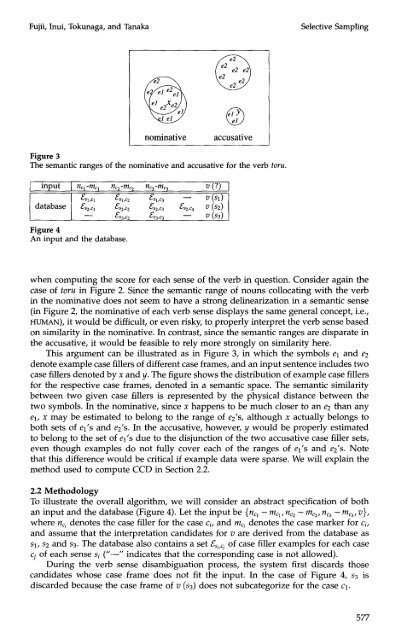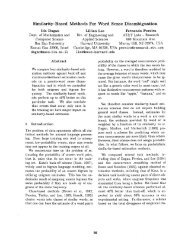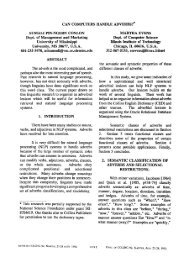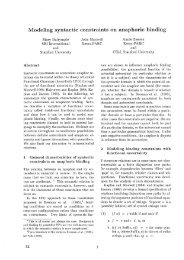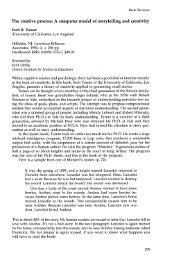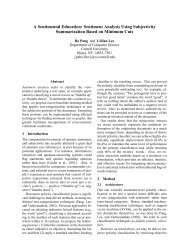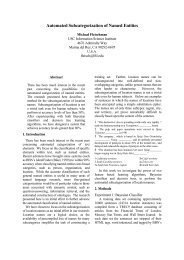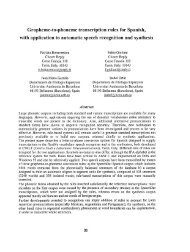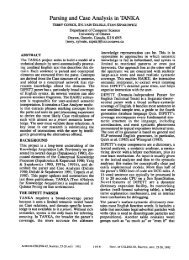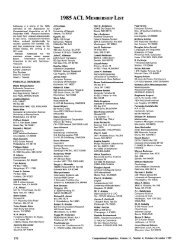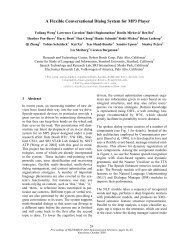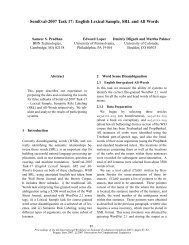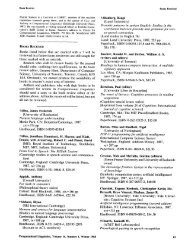Selective Sampling for Example-based Word Sense Disambiguation
Selective Sampling for Example-based Word Sense Disambiguation
Selective Sampling for Example-based Word Sense Disambiguation
Create successful ePaper yourself
Turn your PDF publications into a flip-book with our unique Google optimized e-Paper software.
Fujii, Inui, Tokunaga, and Tanaka <strong>Selective</strong> <strong>Sampling</strong><br />
©<br />
nominative accusative<br />
Figure 3<br />
The semantic ranges of the nominative and accusative <strong>for</strong> the verb toru.<br />
database<br />
nq-mc~nc nc3-rnllc3 v (?)<br />
Cs~,c~ G,c2 &,;3 -- v<br />
Figure 4<br />
An input and the database.<br />
(s~)l<br />
-- ~s3,c2 ~s3,C3 - -- V (S3) J<br />
when computing the score <strong>for</strong> each sense of the verb in question. Consider again the<br />
case of toru in Figure 2. Since the semantic range of nouns collocating with the verb<br />
in the nominative does not seem to have a strong delinearization in a semantic sense<br />
(in Figure 2, the nominative of each verb sense displays the same general concept, i.e.,<br />
HUMAN), it would be difficult, or even risky, to properly interpret the verb sense <strong>based</strong><br />
on similarity in the nominative. In contrast, since the semantic ranges are disparate in<br />
tile accusative, it would be feasible to rely more strongly on similarity here.<br />
This argument can be illustrated as in Figure 3, in which the symbols el and e2<br />
denote example case fillers of different case frames, and an input sentence includes two<br />
case fillers denoted by x and y. The figure shows the distribution of example case fillers<br />
<strong>for</strong> the respective case frames, denoted in a semantic space. The semantic similarity<br />
between two given case fillers is represented by the physical distance between the<br />
two symbols. In the nominative, since x happens to be much closer to an e2 than any<br />
el, x may be estimated to belong to the range of e2's, although x actually belongs to<br />
both sets of el's and e2's. In the accusative, however, y would be properly estimated<br />
to belong to the set of el's due to the disjunction of the two accusative case filler sets,<br />
even though examples do not fully cover each of the ranges of el's and e2's. Note<br />
that this difference would be critical if example data were sparse. We will explain the<br />
method used to compute CCD in Section 2.2.<br />
2.2 Methodology<br />
To illustrate the overall algorithm, we will consider an abstract specification of both<br />
an input and the database (Figure 4). Let the input be {no1 - reel, nc2 - mc2, nc3 - rnc3, v},<br />
where nci denotes the case filler <strong>for</strong> the case ci, and mci denotes the case marker <strong>for</strong> ci,<br />
and assume that the interpretation candidates <strong>for</strong> v are derived from the database as<br />
sl, s2 and s3. The database also contains a set Gi,cj of case filler examples <strong>for</strong> each case<br />
cj of each sense si ("--" indicates that the corresponding case is not allowed).<br />
During the verb sense disambiguation process, the system first discards those<br />
candidates whose case frame does not fit the input. In the case of Figure 4, s3 is<br />
discarded because the case frame of v (s3) does not subcategorize <strong>for</strong> the case cl.<br />
577


